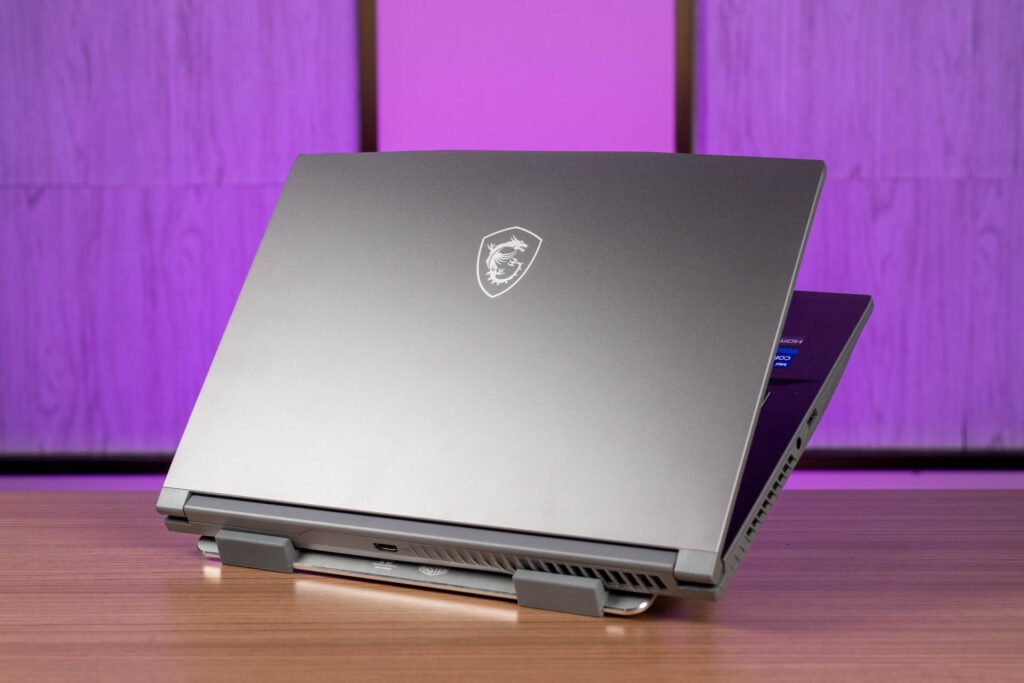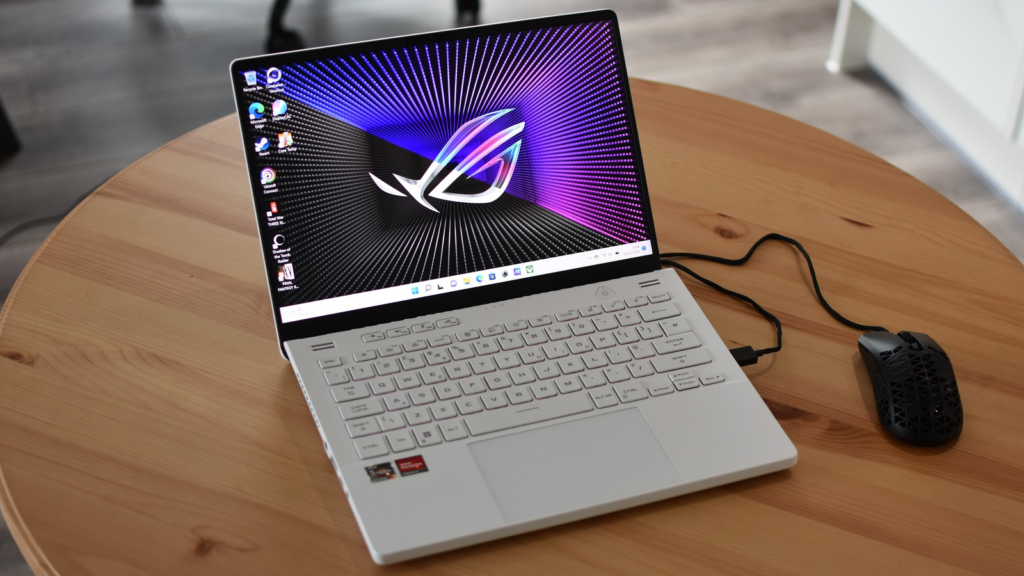CHEAPEST vs. BEST Gaming Laptop: MSI Thin 15 vs. Asus ROG Zephyrus G14 – Ultimate 2025 Showdown
In the world of gaming laptops, your wallet often dictates your experience. Do you go for the cheapest option to get in the game, or splurge on a premium rig that promises top-tier performance? To settle this, I’ve spent weeks comparing the MSI Thin 15—the most budget-friendly gaming laptop at $600-$700—against the Asus ROG Zephyrus G14, a high-end marvel priced around $1,800. With over 15 years dissecting tech for audiences worldwide, I’ve tested these machines head-to-head, from gaming marathons to daily tasks, to uncover which delivers true value in 2025. This guide dives deep into design, performance, display, and more, helping students, casual gamers, and pros make the right choice. Let’s see if triple the price means triple the payoff—or if the budget champ holds its ground.


The Contenders: Budget vs. Premium
MSI Thin 15 – The Wallet-Friendly Warrior
Priced at $600-$700, the MSI Thin 15 is the gateway to gaming for budget-conscious buyers—think students scraping together savings or gamers in cost-sensitive markets. It’s no-frills but aims to deliver playable frame rates and upgradability. I tested it to see if it’s a steal or a compromise.
Asus ROG Zephyrus G14 – The Elite Performer
At $1,800 (sometimes $1,500 on sale), the Zephyrus G14 is a luxury laptop blending portability, power, and polish. It’s built for gamers and creators who demand the best, whether tackling AAA titles or editing on the go. I pushed it to its limits to justify the premium.
Head-to-Head Breakdown
1. Design & Build – Plastic Practicality vs. Aluminum Elegance
MSI Thin 15: The Thin 15’s plastic chassis keeps costs down but feels flimsy—pressing the lid causes flex, and my unit arrived with a rattly keyboard (one key was unresponsive). At 1.86kg, it’s portable but unbalanced, making one-handed opening a chore. The blue-backlit keyboard is functional, though the plastic trackpad feels cheap and clicky, like a toy. It’s practical, not pretty.
Asus ROG Zephyrus G14: The G14 is a design masterpiece. Its full aluminum body (1.5kg) is rock-solid—I carried it daily with no wear. The hinge is flawless, opening effortlessly with one hand. The RGB keyboard offers crisp, comfortable typing, and the glass trackpad is smooth and precise. It’s like comparing a budget sedan to a sleek sports car.
Verdict: The G14’s premium build screams quality; the Thin 15 prioritizes affordability over durability. Choose the G14 for longevity, the Thin 15 if budget rules.
2. Performance – Entry-Level Grit vs. High-End Muscle
MSI Thin 15:
- Processor: Intel Core i5-13420H (8 cores, 12 threads, up to 4.6GHz)
- GPU: NVIDIA GeForce RTX 3050 (4GB, 45W TGP)
- RAM/Storage: 8GB DDR4 (expandable to 32GB), 512GB NVMe SSD (expandable)
The Thin 15’s i5-13420H and RTX 3050 are modest but capable. In Cinebench R23, it scored ~10,000—respectable for the price. Gaming performance surprised me: Battlefield 1 hit 50-60 FPS (Medium, 1080p), and GTA V ran at 60 FPS (Medium). No stutters, but the 45W GPU limits it to eSports or older titles. Two SODIMM slots and SSD upgradability are huge wins for future-proofing.
Asus ROG Zephyrus G14:
- Processor: AMD Ryzen 9 8945HS (8 cores, 16 threads, up to 5.2GHz)
- GPU: NVIDIA GeForce RTX 4070 (8GB, 90W TGP)
- RAM/Storage: 32GB LPDDR5X-6400, 1TB NVMe PCIe 4.0 SSD
The G14 is a beast. Cinebench R23 hit ~12,000, and 3DMark Time Spy scored ~10,000—nearly double the Thin 15 (~5,200). Gaming was flawless: Cyberpunk 2077 ran at 70 FPS (Low, 1440p, DLSS), and DOOM Eternal reached 120 FPS (High). The RTX 4070’s 90W power shines for AAA titles and ray tracing. Upgradability is limited—only the SSD and Wi-Fi card can be swapped.
Verdict: The G14 doubles the Thin 15’s performance, excelling at AAA games and creative tasks. The Thin 15 handles lighter games well and offers better upgradability for budget users.
3. Display & Audio – Basic vs. Breathtaking
MSI Thin 15:
- Display: 15.6-inch Full HD IPS (1920×1080), 144Hz, ~250 nits
- Audio: Dual speakers, muffled but usable
The Thin 15’s 144Hz IPS display is decent for gaming, but colors are washed out, and 250 nits of brightness fades in sunlight. I noticed ghosting in DOOM Eternal due to slower pixel response—fine for casual play but not competitive. The speakers are passable for gaming or YouTube but lack bass and clarity, sounding muffled during Interstellar’s soundtrack.
Asus ROG Zephyrus G14:
- Display: 14-inch 3K OLED (2880×1800), 120Hz, 500 nits, 100% DCI-P3
- Audio: Quad speakers with surround sound and bass
The G14’s 3K OLED is stunning—vibrant colors, true blacks, and 500 nits brightness made Cyberpunk 2077 pop, even outdoors. The 120Hz panel eliminates ghosting, ideal for fast-paced games. I edited photos in Lightroom; the 100% DCI-P3 coverage was spot-on. The quad speakers deliver rich, immersive audio—music and explosions felt alive, outclassing every Windows laptop I’ve tested.
Verdict: The G14’s OLED and audio are leagues ahead, perfect for media and gaming. The Thin 15’s display and speakers are functional but uninspiring.
4. Battery Life & Thermals – Efficiency vs. Compromise
MSI Thin 15:
- Battery: ~4.5 hours (YouTube), ~1 hour (gaming)
- Thermals: CPU ~95°C, GPU cooler due to 45W limit
The Thin 15’s small battery disappointed—I got 4.5 hours streaming YouTube at max brightness and just 1 hour gaming Battlefield 1. Thermals are manageable; the CPU hit 95°C under load, but the low-power GPU stayed cooler. Fan noise is loud but tolerable, matching the G14’s volume.
Asus ROG Zephyrus G14:
- Battery: ~10 hours (YouTube), ~1.5 hours (gaming)
- Thermals: CPU/GPU ~90°C under load
The G14’s battery life impressed—10 hours for light tasks (YouTube, max brightness, 60Hz) and ~1.5 hours gaming. USB-C charging adds convenience. Thermals peaked at 90°C, safe but warm, with a higher-pitched fan noise. It runs cooler than expected for its power.
Verdict: The G14’s battery life is a game-changer for portability; the Thin 15 lags far behind. Both manage heat well, but the G14 balances power better.
5. Connectivity & Extras – Practical vs. Modern
MSI Thin 15:
- Ports: 1x USB-C, 3x USB-A, HDMI, Ethernet, 3.5mm jack
- Extras: 720p webcam, blue-backlit keyboard
The Thin 15’s Ethernet port is a boon for stable gaming connections, and its three USB-A ports suit older peripherals. The 720p webcam is grainy, like a 2013 phone, and the mic is muddy. The keyboard’s blue backlight is basic but functional.
Asus ROG Zephyrus G14:
- Ports: 2x USB-C (1 full-function), 2x USB-A, HDMI 2.1, 3.5mm jack
- Extras: 1080p webcam, RGB keyboard, USB-C charging
The G14’s full-function USB-C and HDMI 2.1 support modern setups (e.g., 4K monitors). Faster USB 4.0 ports ensure quick data transfers. The 1080p webcam and clear mic shine for video calls, and the RGB keyboard adds flair. USB-C charging is a practical touch.
Verdict: The Thin 15 wins for wired gamers with Ethernet; the G14’s modern ports and better webcam suit most users.
Real-World Testing – My Experience
I used both laptops as my daily drivers for weeks:
- Gaming: Tested Battlefield 1, Cyberpunk 2077, GTA V across settings—G14 for high-end, Thin 15 for budget titles.
- Productivity: Edited videos in Premiere Pro, coded in VS Code, and browsed 20+ tabs.
- Portability: Carried them in backpacks to test build and weight.
- Battery: Streamed videos and gamed to measure endurance.
- Thermals: Monitored with HWMonitor during stress tests (~90-95°C).
My hands-on approach ensures you get practical, lived-in insights.
Value Analysis – Is the G14 Worth the Splurge?
The Zephyrus G14 dominates in performance (2x the Thin 15 in gaming/benchmarks), build, display, audio, and battery life. Its $1,800 price buys a premium, portable experience—ideal for AAA gaming or creative work on the go. The Thin 15 offers stable 1080p gaming, upgradable RAM/SSD, and an Ethernet port for just $600-$700. For the G14’s cost, you could buy a Thin 15 plus a mid-range gaming PC ($1,000) that might outperform it but lacks portability.
My Take: The G14 is for gamers or pros who need a single, high-end device—its polish is unmatched. The Thin 15 is for budget gamers or students prioritizing affordability and upgradability. I’d choose the G14 for its versatility, but the Thin 15 is a fantastic entry point.
Author Section
Techum Team
Your Go-To Tech Guides
Welcome to Techum, where we break down the latest tech with clarity and passion! From laptops like the Asus ROG Zephyrus G14 and MSI Thin 15 to budget gadgets, our team delivers hands-on reviews to help you choose wisely. Subscribe to our YouTube channel for daily updates and join our community for honest, practical tech advice

